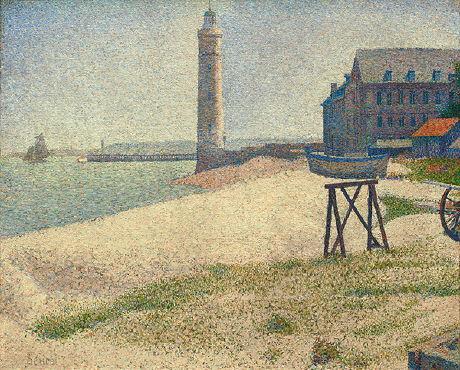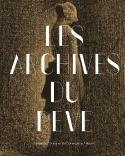Art Of The Day Weekly
#347 - from 22 May 2014 to 28 May 2014

Georges Seurat, L’hospice et le phare de Honfleur, 1886, oil on canvas. Collection National Gallery of Art, Washington DC (exhibition at the Kröller-Müller Museum, Otterlo).
IN THE AIR
The Seurat curse
OTTERLO (The Netherlands) – His works tell us the story of simple and timeless happiness, such as the Parisians bathing on Sundays in the Seine, peaceful Oceanside scenes, or acrobats at the circus. He used the ‘pointillism’ technique that seemed to announce post-Impressionism, and his paintings placed young Seurat, born in 1859, among the rising stars of the 1880 decade. His affinities with literary Symbolism brought him in contact with talented writers such as Verhaeren or Gustave Kahn who saw in him the renovator of painting. But everything came to a standstill in May 1891 when Seurat died at the age of 31, from a devastating diphteria, which also killed his baby boy. Van Gogh had tragically committed suicide less than a year earlier, at the age of 37 ans. But contrary to the Dutch artist, all retrospectives of Seurat are akin to a miracle given the small number of works he left: close to 50 paintings and 200 drawings which have migrated around the world. The centennial exhibition in 1991, at the Grand Palais and at the Metropolitan, was a reference. The Kröller-Müller gives us now a new opportunity to savour this mysterious world, in which men looked like wooden models and the water was a fixed mirage.
• Seurat, master of pointillism at the Kröller-Müller Museum, from 23 May to 7 September 2014
EXHIBITIONS

Claude-Louis Châtelet (1753-1795), Vue de jeu de bague chinois. Drawing in black stone, water colours and gouache Excerpt from the Recueil des vues et plans du Petit Trianon à Versailles, directed by Richard Miquet (1728-1794) 1786
Once upon a time, China
VERSAILLES – There is a lot of talk about China. But that is not new: it was already the case back in 1688. Indeed, at the time, Louis XIV sensed the rise of this enormous market in the Far-East and had sent a Jesuit mission to that region. Throughout the 18th century, the wealthier French society delighted themselves in Chinese decorative arts which they englobed under the generic term of “Lachine”. From the porcelain Trianon of Louis XIV to the Chinese pavilion of Marie Leszczynska, including the laquer boxes which Marie-Antoinette collected avidly, the aesthetes all were contaminated by this true aesthetic epidemic. The passion they triggered-off was similar to that of our period for Chinese contemporary art. The exhibition retraces this fashion by showing some 150 objects from French or European collections: jade bowls, perfume fountains, decorative panels… We will also admire for the first time a gift given in 2014 to the castle of Versailles: a lacquered Japanese dresser with panels, by cabinet maker Antoine-Robert Gaudreaus, for Louis XV’s room at Choisy.
• La Chine à Versailles, art et diplomatie au XVIIIe siècle, at the château de Versailles, from 27 May to 26 Octobre 2014.
The eye of Gisèle Freund
BERLIN – Due to her longevity, she practically photographed the whole 20th century. Gisèle Freund (1908-2000) is celebrated here with nearly 300 photos, most of them portraits among which the ones of Frida Kahlo, Malraux and Gide, as well as the complete series she dedicated to Walter Benjamin.
• Gisèle Freund at the Académie des arts, from 23 May to 10 August 2014.
Carrier-Belleuse, sadly unknown
COMPIÈGNE – Albert Carrier-Belleuse (1824-1887) was a living force as a sculptor and together with Carpeaux was one of the most popular sculptors during the Second Empire. He also rubbed elbows with the Salon. As if this was not enough, he was also Rodin’s master.
• Carrier-Belleuse at Château de Compiègne, from 22 May to 27 Octobre 2014.
End of the century
METZ – What does the art of the end of the 20th century look like? How did visual artists absorb a change of era, with the upheaval brought about by computer science, internet and rampant globalisation? The aim of this presentation is to show just that, with objects, ideas, music and films that left their mark on artists for a long decade.
• 1984-1999. Une décennie at the Centre Pompidou, from 24 May 2014 to 2 March 2015.
AUCTIONS
The Tintin craze
PARIS – How far will his rate go? Hergé, the creator of Tintin, could never have imagined that one day his work would be rated as much as Ingres or Delacroix? This is a recent phenomenon, which may spread: in 2012, the original plate of the album Tintin en Amérique (1932) was sold for €1.3 million. Artcurial, who set this record, presents a monster-auction (1000 lots) that could set new records. The cover in Indian ink of L’Île noire (1942), estimated between €600 000 and €800 000, could well equal it. A copy in perfect state of the deluxe edition of Tintin au Congo can be sold today for approximately €100 000. Hergé is not alone: he is followed by past glories such as Franquin, Hugo Pratt with 25 plates ofEt in Helvetia Corto estimated at €600 000, or even live ones like Bilal. They too should all hit the sky. The ninth art is a lot more expensive than drawing in the 18th century. Who would ever have imagined this?
• L’univers du créateur de Tintin/Bandes dessinées at Artcurial, 24 and 25 May 2014.
ARTIST OF THE WEEK
Michel Nedjar, at the heart of art brut
He has two facets, that of an artist and then of a collector. But he is always in the same “sector”, art brut. Born in 1947, of Jewish origin, Michel Nedjar used the material that seemed most natural to a tailor’s son–cloth. And with it he created dolls. They do not appeal to little girls: the moth is wide open, the eyes are hollow and they are soaked in blood. They were rather away to exorcise the drama of his relatives lost in the Nazi concentration camps. He was noticed by Jean Dubuffet who collected his works. And Michel Nedjar too had a federating role. Together with Madeleine Lommel and Claire Teller he collected the large collection of Aracine, which today is shown at the Art moderne museum in Villeneuve d’Ascq.
• The Christian Berst gallery presents a retrospective of Michel Nedjar, from 23 May to 12 July 2014.
OPENINGS OF THE WEEK

BOOKS
Orsay, a world of drawings
We spontaneously associate the musée d’Orsay with paintings by Courbet, Monet or Van Gogh? But rarely do we think of drawings. And yet the museum has a true treasure with some 80 000 drawings, of which a large part is kept at the Louvre. In order to keep this fund alive in an original manner, art historian Werner Spies made a subjective selection and then asked artists, writers and movie directors to each express themselves on one work of art. David Lynch dissects through calligraphy the mysterious atmosphere of Degouve de Nuncques, Yasmina Reza speaks of the Madrilène de dos by Henri Regnault, Valérie Belin presents a photograph of a study of hats by Boudin (one of the artist’s 7555 drawings!). Anish Kapoor reviews Diable by Redon. This original exercise brings together famous and less famous names (Degas, Manet, Bresdin, Rassenfosse, Fortuny) and delivers interesting contributions even some iconoclast ones. “It is actually surprising that often painter are asked to write and rarely are writers asked to paint, even though painting existed way before writing!” François Morellet wrote.
• Les archives du rêve. Dessins du musée d’Orsay : carte blanche à Werner Spies, Musées d’Orsay et de l’Orangerie/Hazan, 2014, 432 p., €49.90.

